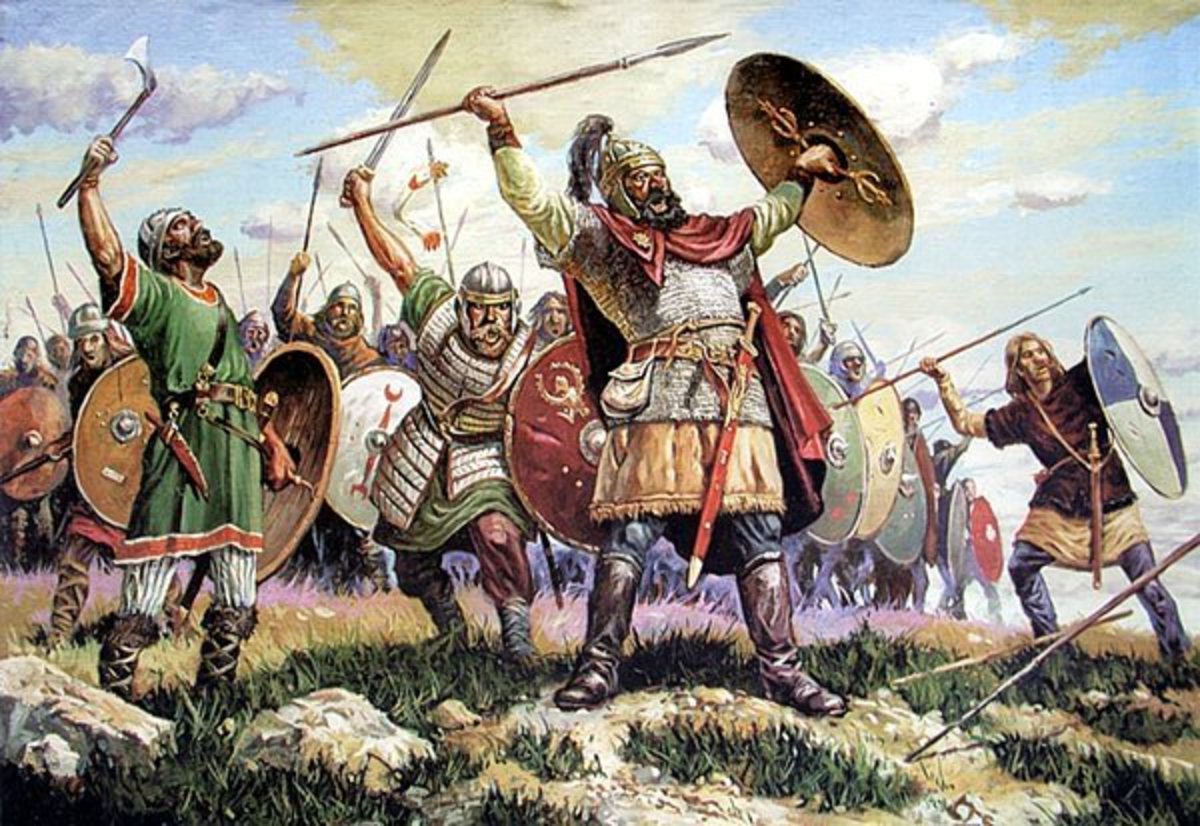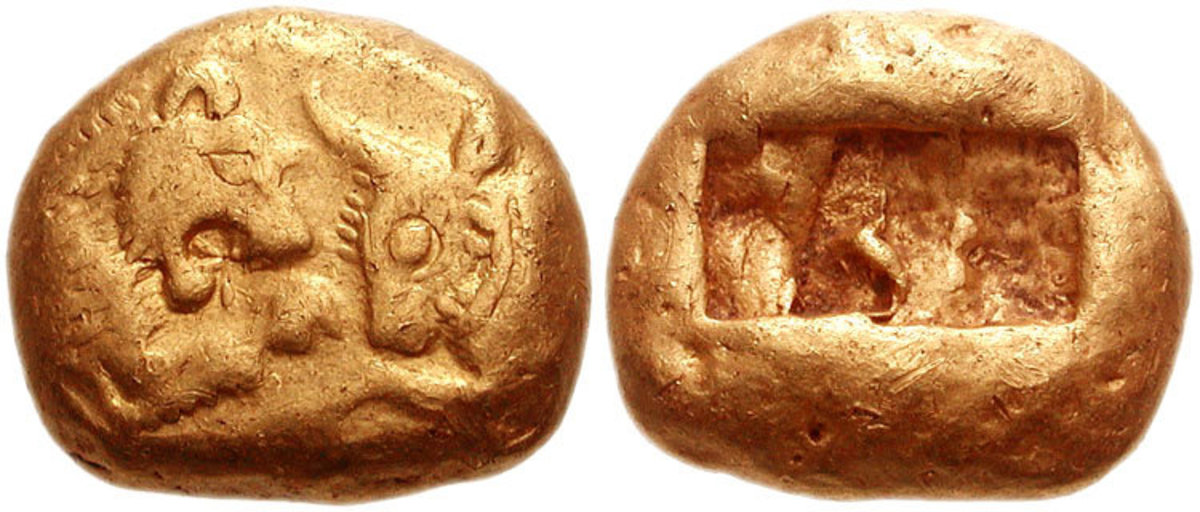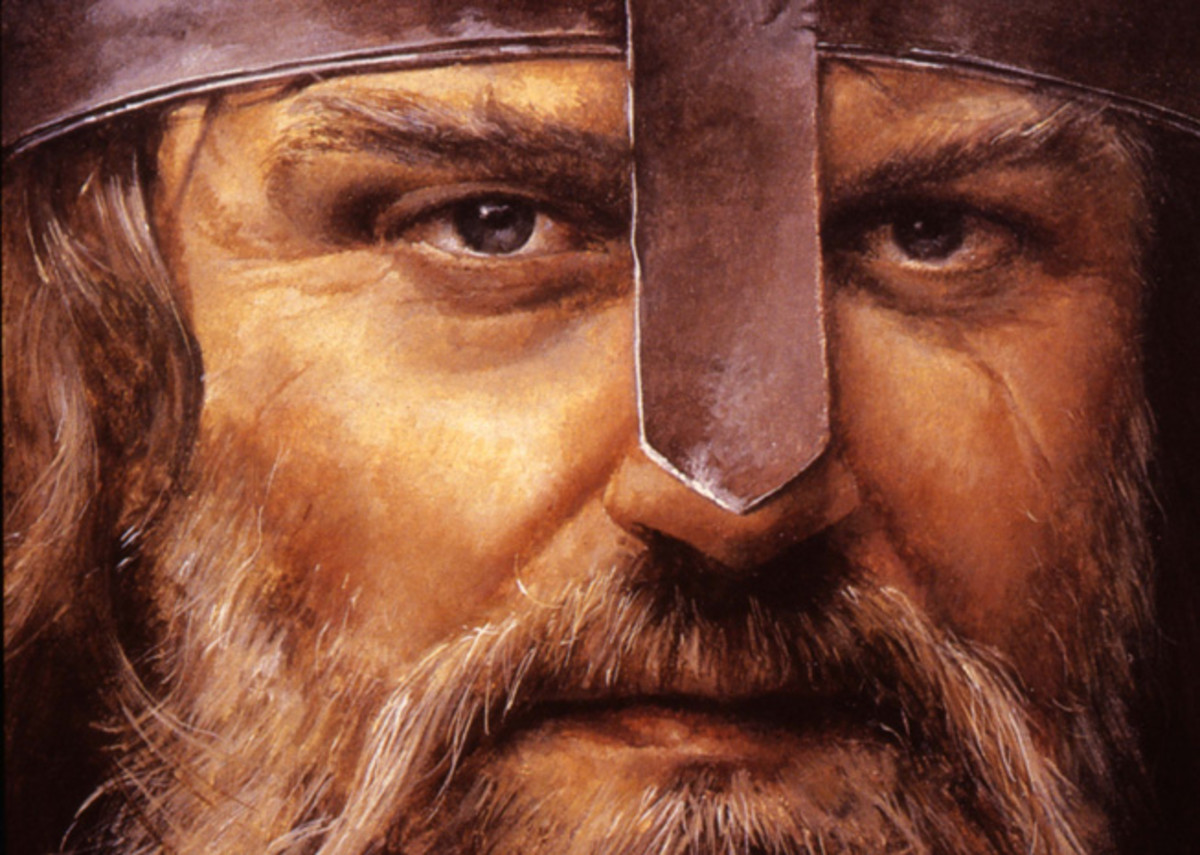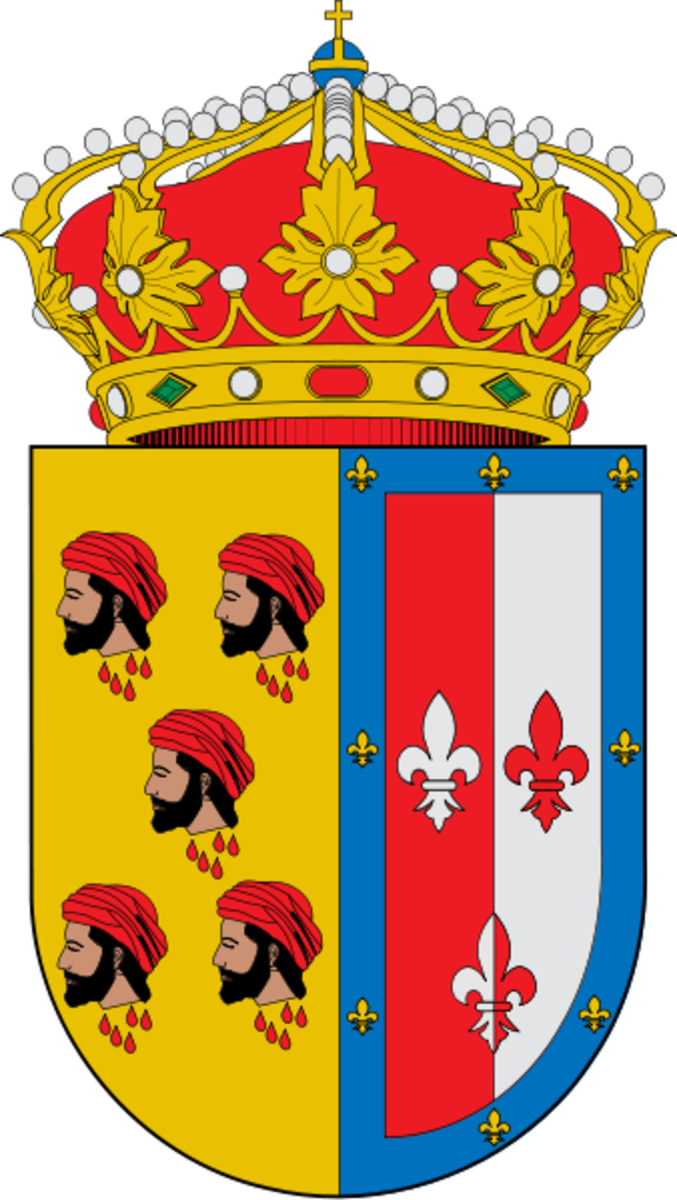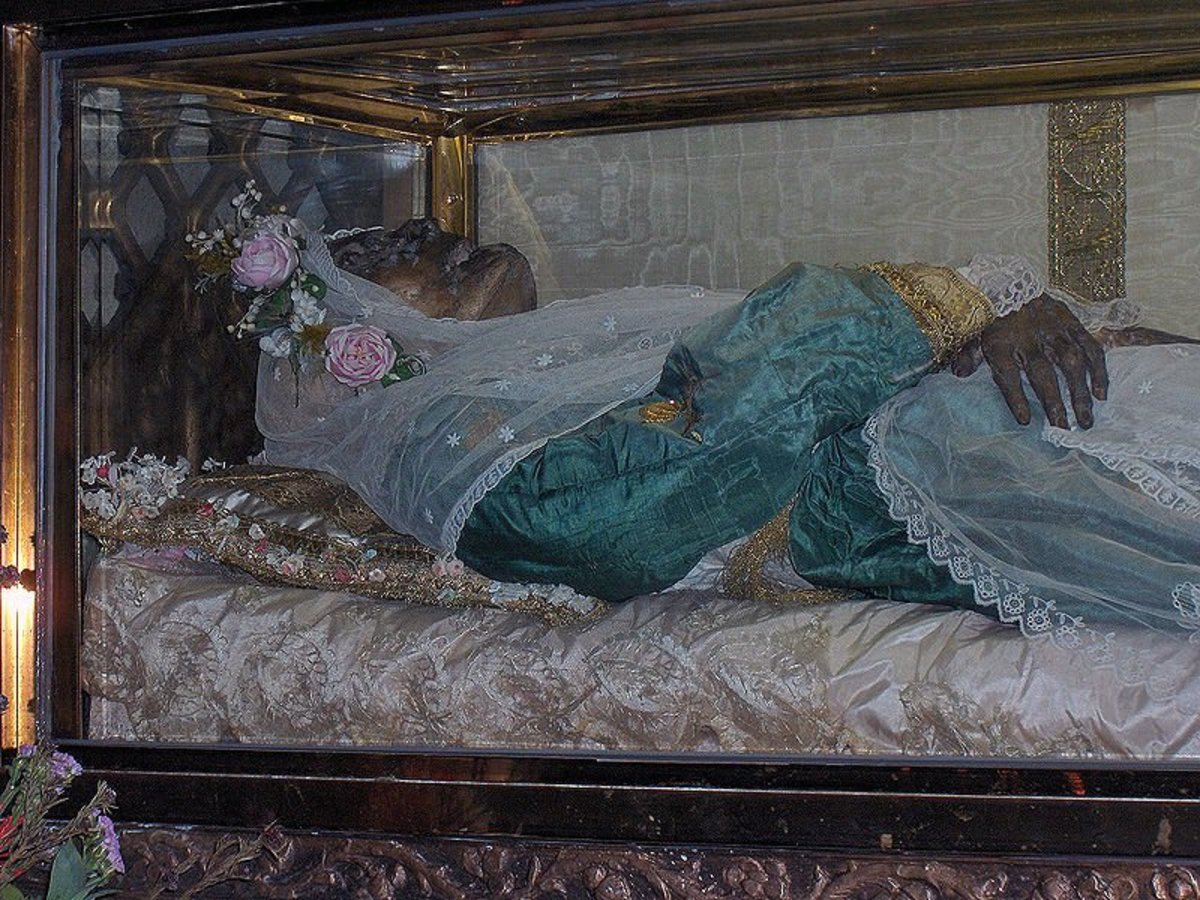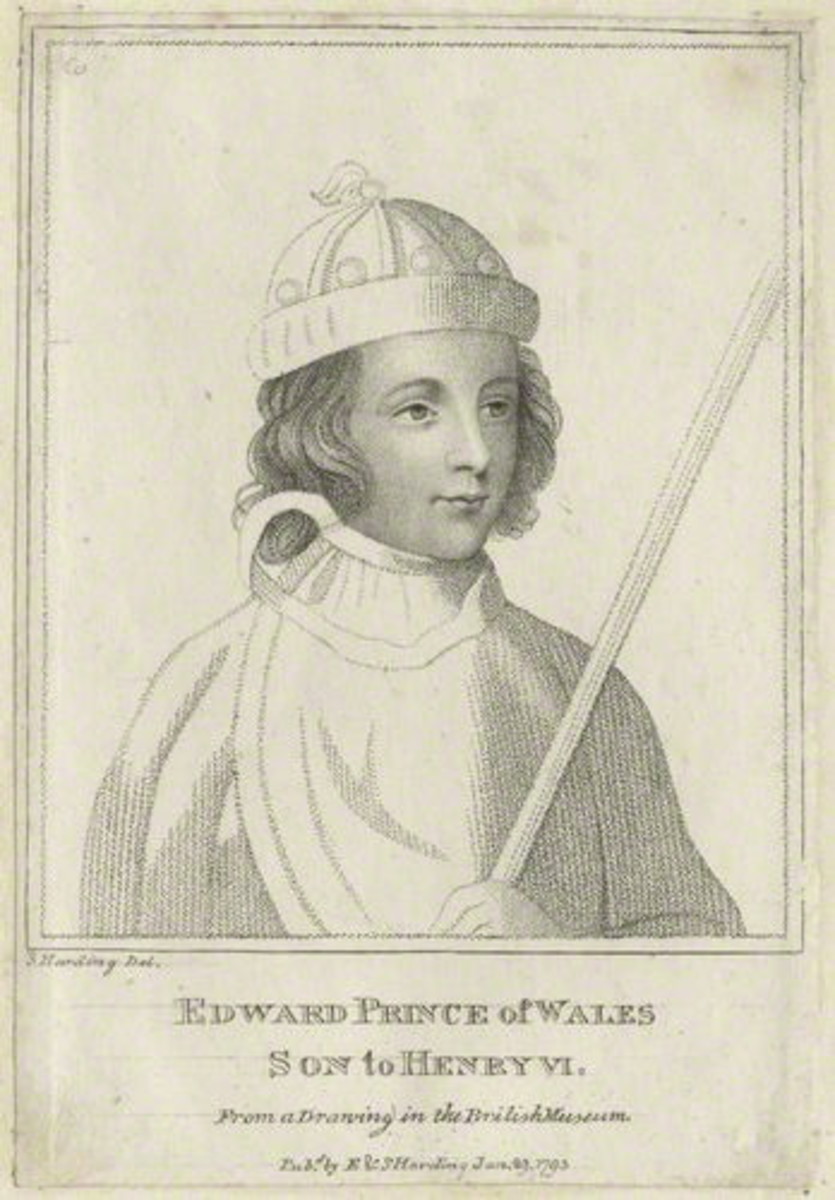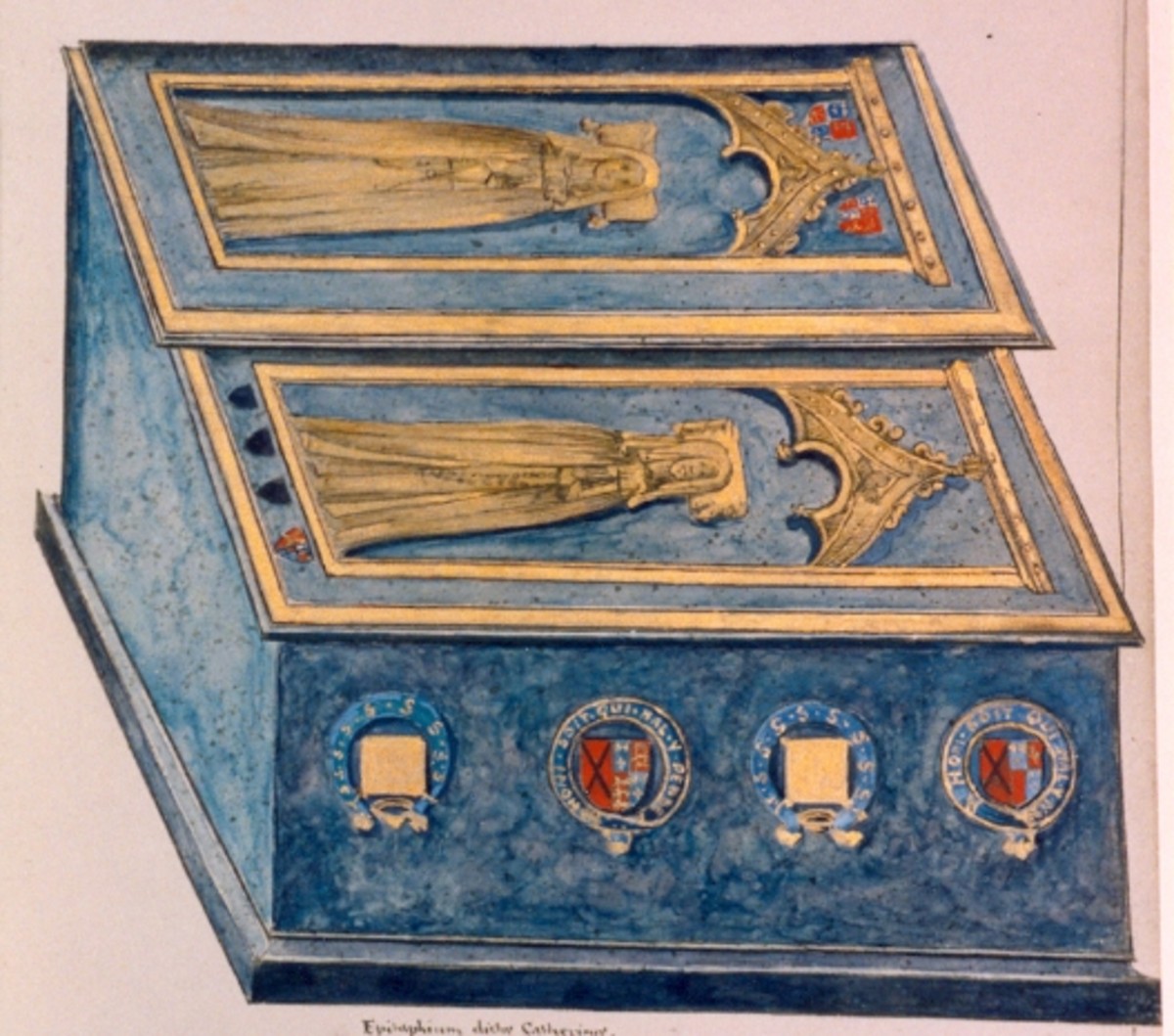Age of Heroes - 10: Attire Evolution - What Warriors, Wives & Workers Wore; & in the Long Halls, a Time for Tall Tales
The ultimate in warriors' equipment, Sutton Hoo parade helm
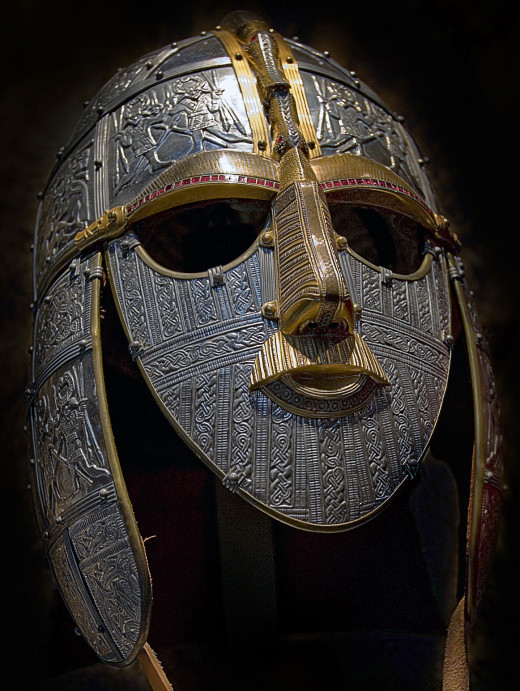
In pre-Conquest England workers came in four classes, crafts-folk, ceorls, freedmen and thralls...
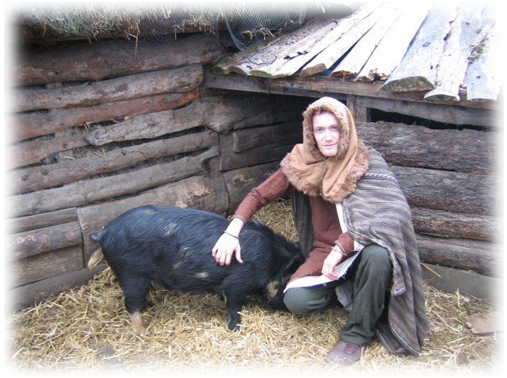
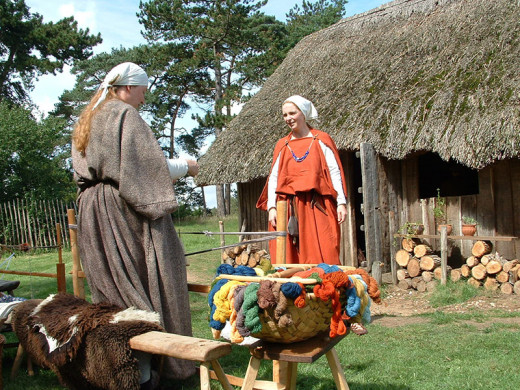
At the time of Caesar
Germanic tribesmen were noted to have worn hides or short garments of hairy skin. Tacitus wrote of spear-armed warriors either naked or clothed in short cloaks.
He implied the lightness or complete lack of clothing was a matter of standing for the foremost warriors, maybe even a link with the gods. Everyday attire was also scanty, little more than cloaks fastened with metal brooches or 'thorns', little else than a pin-like carving from bone or wood to hold the cloak together. Tight-fitting under-garments were worn by the wealthier.
The Angles and Saxons in Britain were better off than those early Germanic tribesmen and wore garments of woollen cloth spun on vertical looms. Nevertheless the styles worn by by the Angles and Saxons were very conservative, harking back to the attire of their continental forefathers.
Cloaks
Anglian, Jutish and Saxon males generally wore cloaks styled much the same as those on the Continent. Cloak brooches dating back through the period of settlement in southern Britain are common finds. Style changes are more in the manner of pins and brooches than in the garment itself. Earlier brooches tended to be of a cruciform style with a bowed section to allow the material to be pulled through between the mountings and pins. Later brooches tended to be round. Regional variations show the Angles chose shapes that did not correspond with those of the Saxons unless they were neighbours.
The cloaks were rectangular, body length and about 5 foot broad (1.5m) when pinned on the right shoulder as they appear in most contemporary illustrations, hanging to knee-length. Most cloaks were edged with tablet-woven braid.
Tunics
Woven, generally from woollen yarn, tunics were worn belted at the waist so that the hem was raised to the knees. Worn without a belt, the tunic would hang to calf level. There is some doubt about the sleeves, whether thry were rumpled, drawn back over wrists because they hung over the fingers otherwise. Others think creasing in illustrations was 'artistic licence' by those drawing the images.
Necks were either square-cut across the neck, or 'crew-necked, reinforced with a placket and closed either by drawstring, brooch or bead. A mix of colours could be woven into the fabric, although plaid was standard. Oddly enough, digs in the homelands - modern-day Schleswig - show a tendency towards check or 'tartan' pattern.
Trews and shoes
Leggings found in the homelands take the form of trews, later perhaps as 'breeks' (see the Hub on Ragnar Lothbrok, 'Leather Breeks' - breeks would be more familiarly known in later years as breeches). One pair found in a Danish bog at Thorsbjerg in SW Jutland had 'feet' sewn onto them with slits at the ankles for easier dressing. By the 6th Century separate leggings had become stylish, allowed to hang loose around the angles over boots. Also long fabric strips were bound closely around the calf, like 'puttees' (leggings worn by British soldiers in WWI, originating and worn by British and Indian troops in India) or more widely-spaced. The Old English for these leg-bindings was 'wininga' and were normally worn over the legs of trews. The binding gave the benefit of holding in the loose folds of the amply proportioned trews to prevent wear and tear, additionally giving protection from the cold in bad weather. They were especially useful on campaign. Few shoes survive, although it is known they were called 'scoh' or 'gesceo' (pronounced: gesho) or 'switler' in Old English, all denoting leather or hide footwear or boots. Best examples to come down to us are from southern Scandinavia, broadly alike in design and widely-made from cow-hide.
Belts were also leather, normally about an inch wide (2.5cm), shown in the breadth of copper-alloy belt buckles and strap-ends, all of which have been found long after the leather has rotted. There were cross-belts used for carrying sword-sheaths (as well as bags for arrows) for ceorls who would draw the arrows from their bags on the field of battle and ram them point down into the earth, to be pulled up and loosed off in quick succession.
Headwear
Anglian and Saxon manuscripts of the 10th and 11th Centuries show warriors wearing caps with a typical forward-drooping crown, known to us as the 'Phrygian cap' (originating in Asia Minor). The style became associated with the Germanic peoples in Britain. Problems arise with the evidence, however. Many late drawings were copied straight from Carolingian or Byzantine originals and are thus useless as indicators of headwear worn at these times. In all likelihood materials used to make the caps would have been wool or even felt - as head-warmers. Leather caps may have been worn in fighting in the (vain) hope a glancing blow would not injure the wearer.
Everyday
"When not engaged in warfare they spend a certain amount of time hunting, more in idleness [than of necessity], thinking of nothing else but but sleep and eating. For the boldest and most warlike have no regular tasks, the care of house and home and fields left to the womenfolk (where have we heard that one before? Sounds more like the 'Hagar the Horrible' cartoons) old men and weaklings of the clan. In so dawdling away their time they show an odd inconsistency - at one basking in indolence yet hateful of peacetime". This is how Tacitus describes the everyday life of Germanic warriors. although written four hundred years before the Angles and Saxons migrated to Britain, his comments applied equally to the later existence of the Anglian and Saxon warriors here. Cultivating the land was thought too lowly for a warrior class who sought relief from boredom in hunting. Idling, eating and drinking all took up non-combat hours of a fighting man's life.
On into the period of settlement some thegns put their thoughts to activities on the land. Away from the 'burhs' (the towns and cities), thegns in charge of their five-hide holdings would oversee the harvest, stockmanship, even to stripping off to the waist and helping out. In the early and middle eras the hall was the epicentre of activity for the 'hearthweru'.
IN THE LONG HALLS
The hub of social life, the long hall or 'heall' was where drinking, gambling, the rough-and-tumble of bored warriors took place, mock brawls and name-calling or drinking games. The bonds were strengthened between warrikors by sharing the highs and lows, listening to poets (and pelting them with stale bread if the lord was absent) and receiving gifts from their lords.
At Yeavering in Northumberland archaeological digging revealed a royal hall, home to one of the kings of Bernicia in the early Christian era. A great open space was centred on a hearth, a fire pit. Long tables and benches were set up for feasting and taken down when the company readied themselves for the night, normally in the small hours. Some privacy was gained by erecting temporary partition walls, making small rooms. Women of higher standing lived in accommodation with their servants. Young men, 'geoguths', (pronounced 'youths') and unmarried warriors or thegns lived within the main hall. The married men lived in separate dwellings or on their own lands elsewhere.
By the long hall at Yeavering was a 'pit theatre', an assembly area with seating for over a hundred. This is where the king made his announcements. Around the hall a number of smaller buildings provided storage, additional dwelling rooms and workshops. Added to these were small sheltered shrines. In this environment lived the king's men, sleeping and training for the fighting that would surely come.
A 10th Century king's estate near Cheddar in Somerset (Wessex) has a range of buildings around a central hall like that at Yeavering, which would have belonged to royalty. A stone chapel was the only difference. There was plainly little change in the upholding of royal might over three centuries.
Best known in its descriptive capacity as an observation of a Germanic royal household is BEOWULF. The era it was put onto paper is thought to be 11th Century, but as an oral tradition goes back to about the time the later (late 6th/early th Century) Anglian migrants set foot on these shores. The final form of the BEOWULF transcription is accredited to Mercian tradition in its linguistic style but harks back to Geat/Gaut/Gotar (Gothic) oral tradition at about the time of Hygelac in the early 6th Century. It opens in the long hall of King Hrothgar (pron. 'Rothyar', early form of Norman 'Roger') of the Danes at Hleithra (Lejre, near Roskilde, the later Danish royal seat before Helsingoer - Elsinore in Hamlet). The hall is named 'Heorot' - Hart - covered with gilded wooden carvings, famed throughout the northern kingdoms. After drinking bouts the men would sleep on the benches. It is in the light of this background that the horror of the troll Grendel would have struck home, men picked from their benches, pulled apart and devoured. The story would have stemmed from long, dark winter nights, the outcome of fertile imagination and copious drinking... This was how many tall stories began, such as Beowulf telling of how he swam across the strait with narwhals snapping at his legs. Younger minds would have been terrified, older ones would have known them for being tall stories, but enjoyed listening all the same.
Feasting and drinking
Food taken in these long halls would have been high in protein and calories. Root vegetables would have been boiled in large cauldrons hung from chains anchored in the rafters over the firepit and dished up as broth. Carcases would be roasted whole over an open hearth by a blazing log fire. Sausages, horsemeat usually, were known as 'maerheccel'. Bread was common, and the term 'lord' was derived from the O.E. 'hlafod' (pron. 'lavod', loaf giver). This indicates bread was handed out at feasts to the king's, ealdorman's or thegn's followers. Eating tools were not so common, but knives (the 'metseaxe', meat-seaxe) were smaller versions of the single-edged fighting blade. Spoons (metasticca') would have been of bone or wood henerally, decorated horn or metal for the wealthier. Forks were unknown, even to the nobility and kings until the fourteenth/fifteenth centuries when introduced to the rest of Europe from Italy.
Alcohol was the mainstay not only of Germanic feasting. The most prized drink in the northern kingdoms was mead, made largely of fermented honey - although the early word 'medu' could mean almost any form of fermented drink . Malted ale, 'mealteloth', was also much appreciated. Decorated drinking vessels could be of horn - wild cattle were usually the best providers, although imported glass bowls or beakers were found at the tables of higher-ranking lords. Early poetry mentions warriors tking part in social eating and especially drinking, 'where mead flowed like water' if we believe them.
Seating closer to the lord - king, ealdorman (later earl), thegn - showed your standing and arguments often broke out over someone usurping another man's position on the bench. Senior churchmen, ealdormen or earls would be closest to the king, a 'mirror' on their relative positoons on the field of battle. Those closest to the king might be served by the lady of the house as a show of special hospitality.
Feasting could last all day and night, usually to excess, and was a way of bonding lord to warrior. An open-handed lord would be praised long after his demise. Often important matters would be talked over before everyone became too drunk to listen - or care - and might be broached again in the cold light of the following day when all were sober again. Boasting, quarrelling and fighting might break out, leading to armed combat early the following morning. A man had to answer for his foolishness, after all...
Passing the time of day - or night
Hunting with hounds and hawking were thought fitting as leisure activities for a noble from thegn upwards... to kings. Wild beasts at the time tended to worry those rearing domestic livestock, and bears, boar and wolves were high on the list of quarry. Besides these there were plentiful deer that got onto the cultivated strips where root vegetables and cereal crops grew. Smaller prey such as beaver, hare or otter were hunted with smaller hounds or speared. Meat was found more on noblemen's tables than in the homes of the 'lower orders'. Meals were served twice daily, but snacks were taken by working men to be eaten around noon. Nobles or warriors ate when they rose from their slumbers unless there was something 'going on'.
The main hunting weapon was the spear, and hunting bows were useful to have on you at times, but there were some who took on boar with sword and shield! Hunting hounds were bred for different skills, for fast running, for size or sense of smell. Hunting hounds are shown on the Bayeux Tapestry, being taken onto Harold's ship at the start of his voyage (to Normandy by all accounts, but this is wishful thinking on the part of the Normans.and no-one has yet raised the real reason why Harold sailed in AD1064). In the poem of the Battle of Maldon one of Ealdorman Byrhtnoth's close friends frees his hawk before the fighting starts.
A number of board games is known from this time, including a form of backgammon, nine-men's-morris and fox-and-geese. The last mentioned is a form of draughts (checkers) still played widely around Europe and where Europeans settled around the globe. Chess arrived with the Vikings, having been seen by them on their trading stopovers in the east. A set of gaming pieces made from horses' teeth was fond in a grave at Faversham in Kent, but the nature of the game is not clear. Knut Sveinsson (King Canute to some) was a keen - and expert - chess player. Some leaders devised their battle tactics based on games of chess.
Tacitus noted the Germanic warriors were taken by dice games, to the extent where even lives hung on the outcome of a throw. However, we do not know how prevalent this tendency was among the Angles and Saxons at any level.
Word games and the poet's craft
Pagan Angles and Saxons were semi-literate, and their descendants in Christian times had not changed to any great extent. The runic alphabet, the 'futhark' was widely known of but it was generally used by the learned to mark ownership or craftsmanship, and to cast spells in 'hwicce' (witch) craft. The ability to read or write in runes was restricted largely to the pagan 'priesthood', later even the Christian priesthood to whom the Latin alphabet was at first a standby, and later to whom the futhark was merely a matter of curiosity. However the runic marks stayed in use in the northern lands well into the main Viking era. Sagas such as Beowulf are not likely to have been read out by warriors or thegns but they would have been passed on from memory, told by storytellers in the same way as skalds - hall poets - of Viking society moved around between patrons. Recitations of Beowulf would have been kept to high days and holidays. As well as a form of entertainment and idea of service and loyalty was passed on with the telling. There is some runic 'graffiti' carved onto the balustrade of the Hagia Sofia, from when the Norsemen served in the Varangian Guard or arrived in Constantinople for trade. It translates something like: 'Eirik was here'.
A different form of entertainment altogether was the riddle. Some were ribald or downright lewd, but usually with innocent endings, perhaps typically with reference to a warrior's outfit or an agricultural tool. From the Exeter Book we have one example to hand:
"I am one alone, wounded by iron, battered by weapons, tired of play-fighting, weary of sword-blades. I often see war, hard fighting with no hope of respite, or any help, before I, amongst warriors am altogether broken. Hammered blades, hard-edged and deadly sharp batter me, the handwork of smiths biting in the burh. I must ever stay the hateful strife. Never anywhere man lives could I find the cure to heal my scars with herbs, but the wounds grow on me by day and night".
The answer to the riddle is "I am a shield". Others are also known, almost a hundred in the Exeter Book itself, but not all could be solved as easily as this example above. For a warror or thegn about to embark on a campaign - possibly without return - the long hsll with its great, central hearth, copious supplies of drink and fellowship was a welcome with no equal. Bede tells us of one of the senior men under King Eadwin of Northumbria, who likens the short life of a warrior to the flight of a bird through a firelit long hall on a winter's night. The outside world in darkness, lashed by bone-chilling winds is what awaits beyond the comfort and warmth. The only fit place for any man of worth in winter-time.
I hope you enjoyed reading this mini-series. The last one is probably of more interest to the ladies, as opposed to all the macho business in the first eight! It might help explain a lot, especially the outlook on dying that re-emerged from time to time amongst the military: "I don't mind dying, (God/Odin/Wotan/Woden) but can you leave me standing at the end of this?"
Next - 11: Fool's Gold
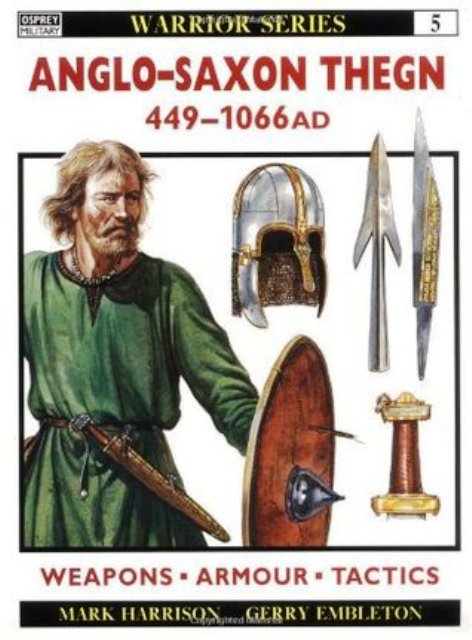
Mark Harrison and Gerry Embleton present one of the first-rate Osprey Warrior series, 'Anglo-Saxon Thegn' (pron. 'thane', as in Shakespeare), and take us through the development process of this minor nobleman from early days to the 'Conquest' era. Amply illustrated, with monochrome photo images and diagrams, the narrative is maintained to give as much accuracy as current knowledge affords. Images are taken from illustrations of the time to show period perception.
Ordinary folk in Aengla Land (England) bide their time at the back of Caldbec Hill on 14th October, 1066
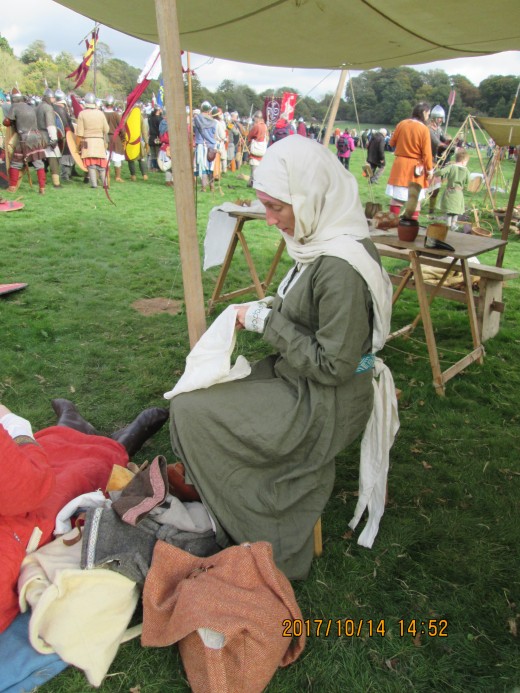
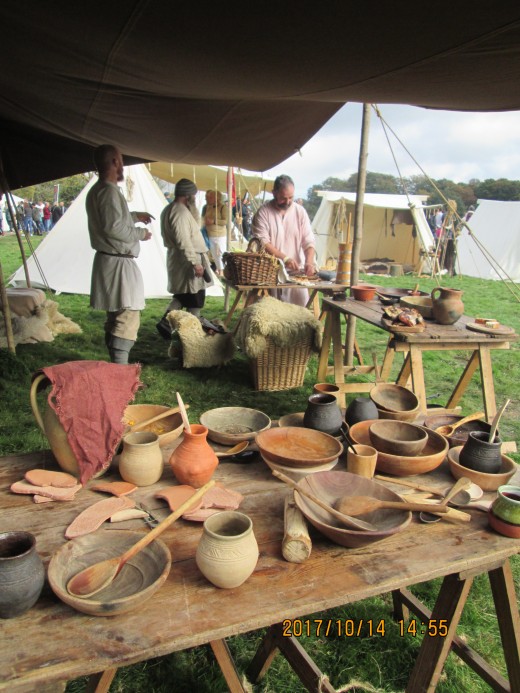
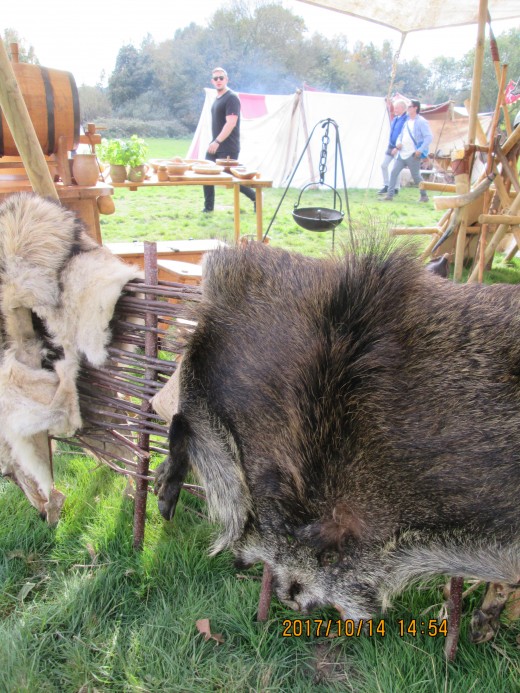
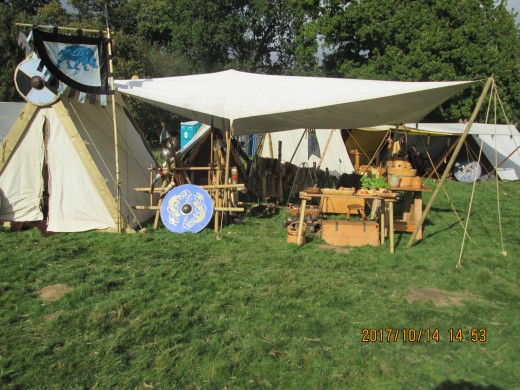
The pictures above and below show men dressed as warriors, thegns and nobles involved in the re-enactment of the battle on Caldbec Hill at Battle near Hastings. One is dressed as King Harold - although he hardly behaved in the manner of a leader whose kingdom is threatened - and there are women in the clothes their ancestors would have worn in the 11th Century, involved in activities around the campsite that wouldn't have been out of place then.
Pictures from a Battle scene - 14th October 1066 was a day to remember, a day to mourn a king's death at the hands of three of Duke William's knights

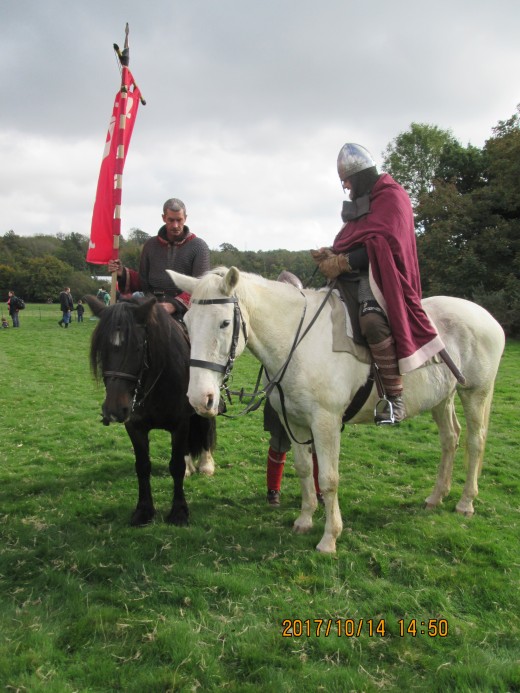
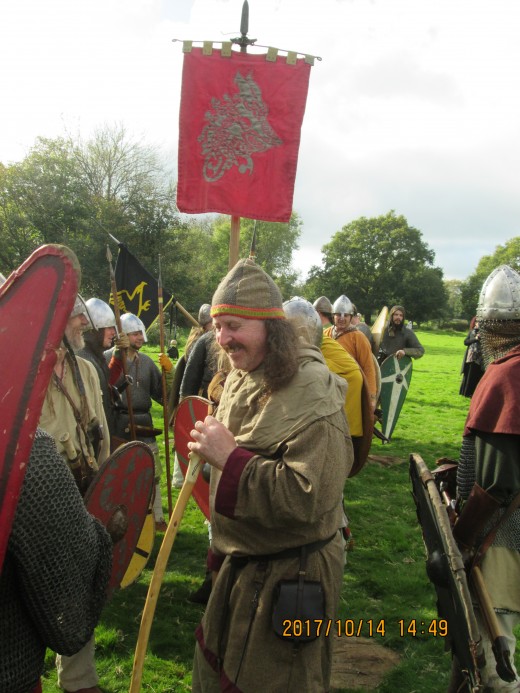
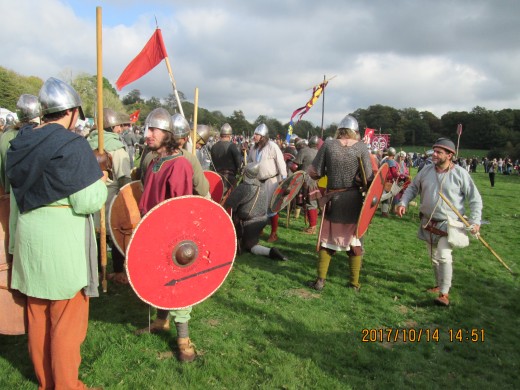
From the time Raedwald, king of the East Angles ruled, to when King Harold stood his men to on Caldbec Hill (at Battle, six miles inland and uphill from Hastings, Sussex) warriors' equipment had changed only in detail. There was the addition since the time of Knut/Cnut of a new rank of warrior, the 'huscarl', supported in the same way as the thegn and king's thegn by the five hides of land that provided him with income for horses, weaponry and chain mail. There was also his favoured weapon, the long, curved-handled axe known as the 'Dane Axe'. There was also his appearance. As a rule huscarls (huscarlar) wore their hair longer than their English counterparts until the time of Knut. That changed and the shorter hairstyle you see on the Bayeux Tapestry was the order of the day. Many Danes and Anglo-Danes in England not directly involved with the king and his household wore their hair longer. Harold's younger brother Tostig is believed to have had longer hair, the fashion in Northumbria where he'd been since King Eadward appointed him as earl in 1055. Little had changed in the North since the time the Danes occupied what is now Yorkshire and Lancashire as the Kingdom of York, and Halvdan Ragnarsson became its king in the mid-late 9th Century. The eastern shires also, the Danelaw and the former Kingdom of East Anglia, saw the way the Danes dressed, bathed and ate as the new order (Engllsh women preferred the Danes to their own men because the Danes were cleaner and trimmed their beards regularly)
© 2012 Alan R Lancaster


